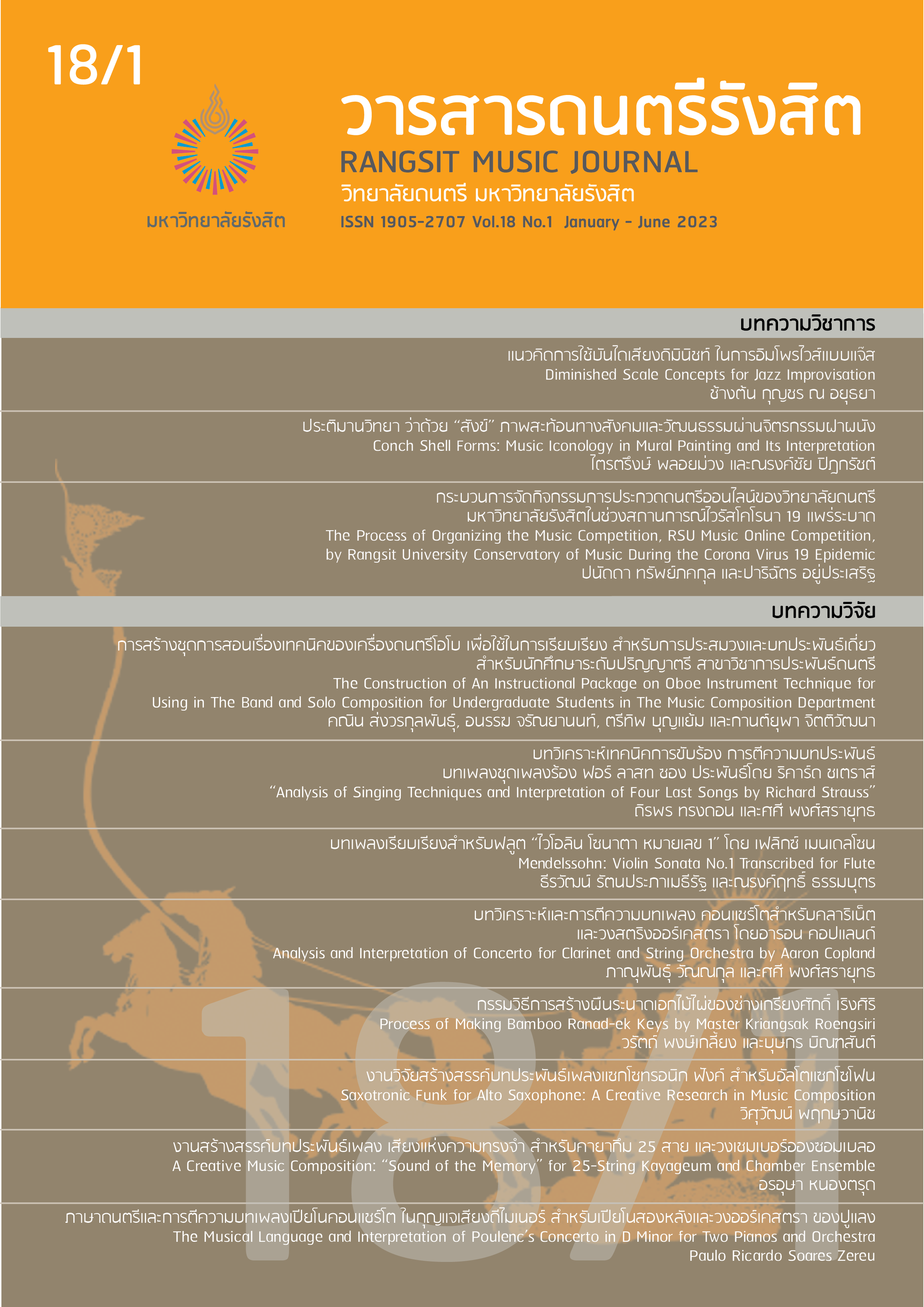Process of Making Bamboo Ranad-ek Keys by Master Kriangsak Roengsiri
Keywords:
Instrument Making, Bamboo Ranad-ek Keys, Kriangsak RoengsiriAbstract
The thesis “Process of making bamboo Ranad-ek keys by Master Kriangsak Roengsiri” sought to investigate the biography and process of making bamboo Ranad-ek keys. Furthermore, to examined the factors that influence the sound quality of Master Kriangsak Roengsiri's bamboo Ranad-ek keys. According to the findings of the research, Master Kriangsak Roengsiri studied the making of Ranad-ek keys from his father-in-law, Master Chor wutracha, and observed the works of many artisans. He now works as a Ranad-ek keys artisan as well as a farmer. According to the research, Master Kriangsak Roengsiri's process of making bamboo Ranad-ek keys included 17 steps. There were bamboo selection, segmentation, cutting, soaking, drying, size selection, making bamboo into a bar, side modification, draw pattern lines, draw lines to prepare for the drilling hole. Nail for preparing a drilling hole, removing the head and bottom, drilling a hole for a rope to be threaded, below decoration, scoop lines beneath the keys, lead sticking, sound tuning, and polishing. The final step was to paint, polish, and wax the surface. Each step necessitated attention to detail and craftsmanship experience, which influenced the sound quality of the bamboo Ranad-ek keys.
References
Chaisare, Pichit, Ranat-ek (Interviewee). March 16, 2021.
Diagram Group, Editors. Musical Instruments of the World: An Illustrated Encyclopedia. New York: Sterling Pub. Co., 1997.
Orachun, Chetnarat, Thanakorn Phibanrak, Chuwong Ubalee, and Kanokwan Yusawai. “Guidelines of Herbal Wisdom Conservative Using Community Participatory: A Case Study of Thakain-thong School (Petcharo-patham) Kaokitchakut District in Chanthaburi Province.” Complete Research Report, Rambhai Barni Rajabhat University, 2018. (in Thai)
Phattayakul, Bamrung. The Method for Inventing the Ranat-ek of Khru Tuean Phattayakul, in Memorial Cremation Ceremony of Mr.Tuean Phattayakul, National Artist Performing Arts (Thai Music) 1992, edited by Phattanee Phromsombat, 125. Bangkok: Idea Square Limited Partnership, 2003. (in Thai)
Phatthanawiboon, Rungnapha, Bunyarit Phuriyakorn and Walaiporn Sathitwiboon. Bamboos in Thailand. Bangkok: Rongphim Chumnumsahakorn, 2001. (in Thai)
Pikulsri, Chalermsak. Ak Sara Duriyang Thang Ranat Ek. Bangkok: Odeonstore, 2005. (in Thai)
Roengsiri, Kriangsak. Ranat-ek, (Interviewee). February 15, 2020.
___________. September 23, 2020.
___________. October 9, 2020.
___________. October 29, 2020.
Royal Society of Thailand. The Royal Institute Dictionary 2011. Bangkok: Royal Society of Thailand, 2013. (in Thai)
Thamviharn, Sangobsuek. Duriyang Thai. Bangkok: Chulalongkorn University Press, 2002. (in Thai)
Yupho, Thanit. Khrueang Dontri Thai Phrom Duai Tamnan Kan Pasom Wong Mahori
Piphat Lae Khrueangsai, Bangkok: The Fine Arts Department, 1980. (in Thai)
Downloads
Published
How to Cite
Issue
Section
License
Copyright (c) 2023 Rangsit Music Journal

This work is licensed under a Creative Commons Attribution-NonCommercial-NoDerivatives 4.0 International License.







